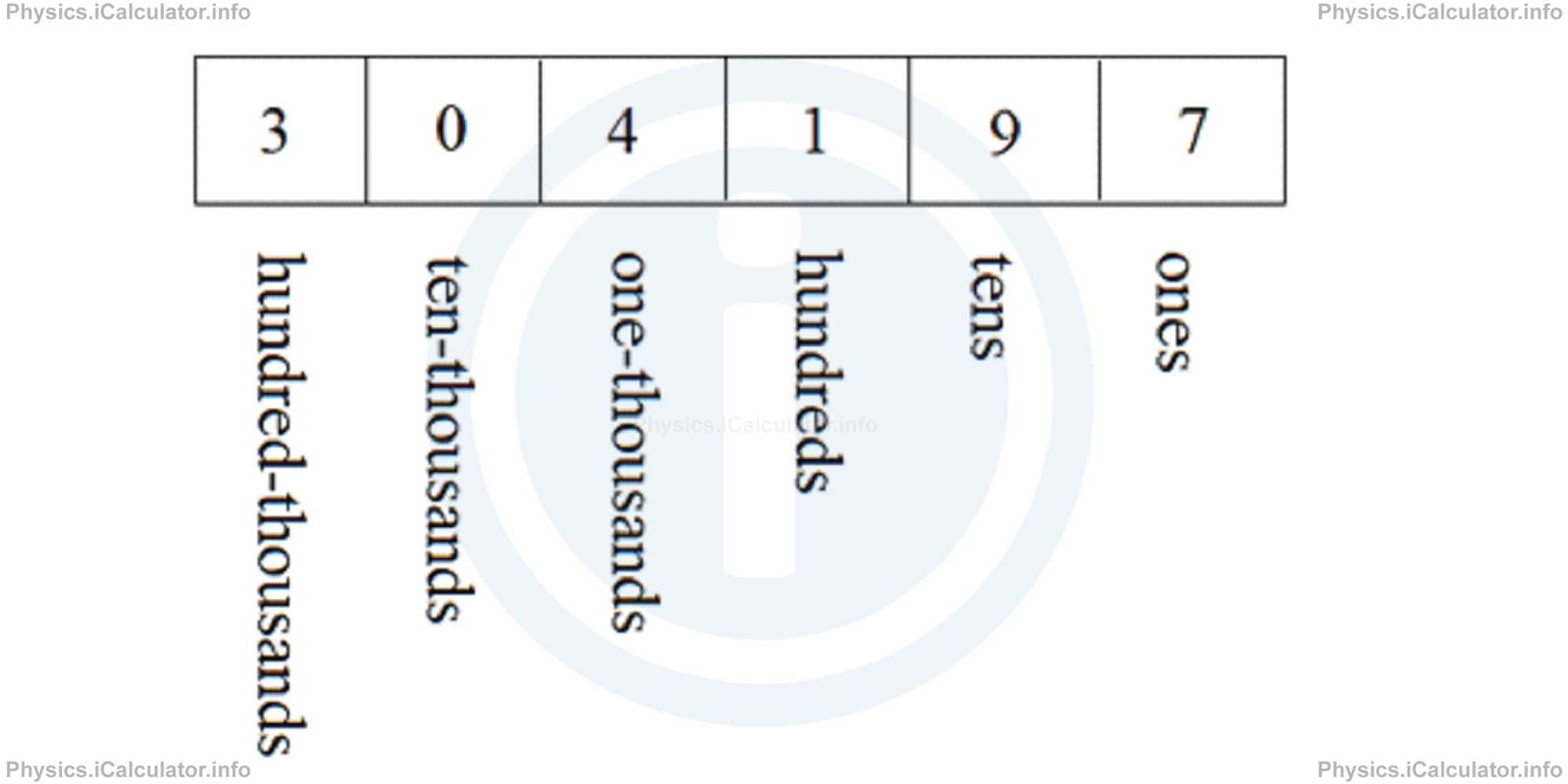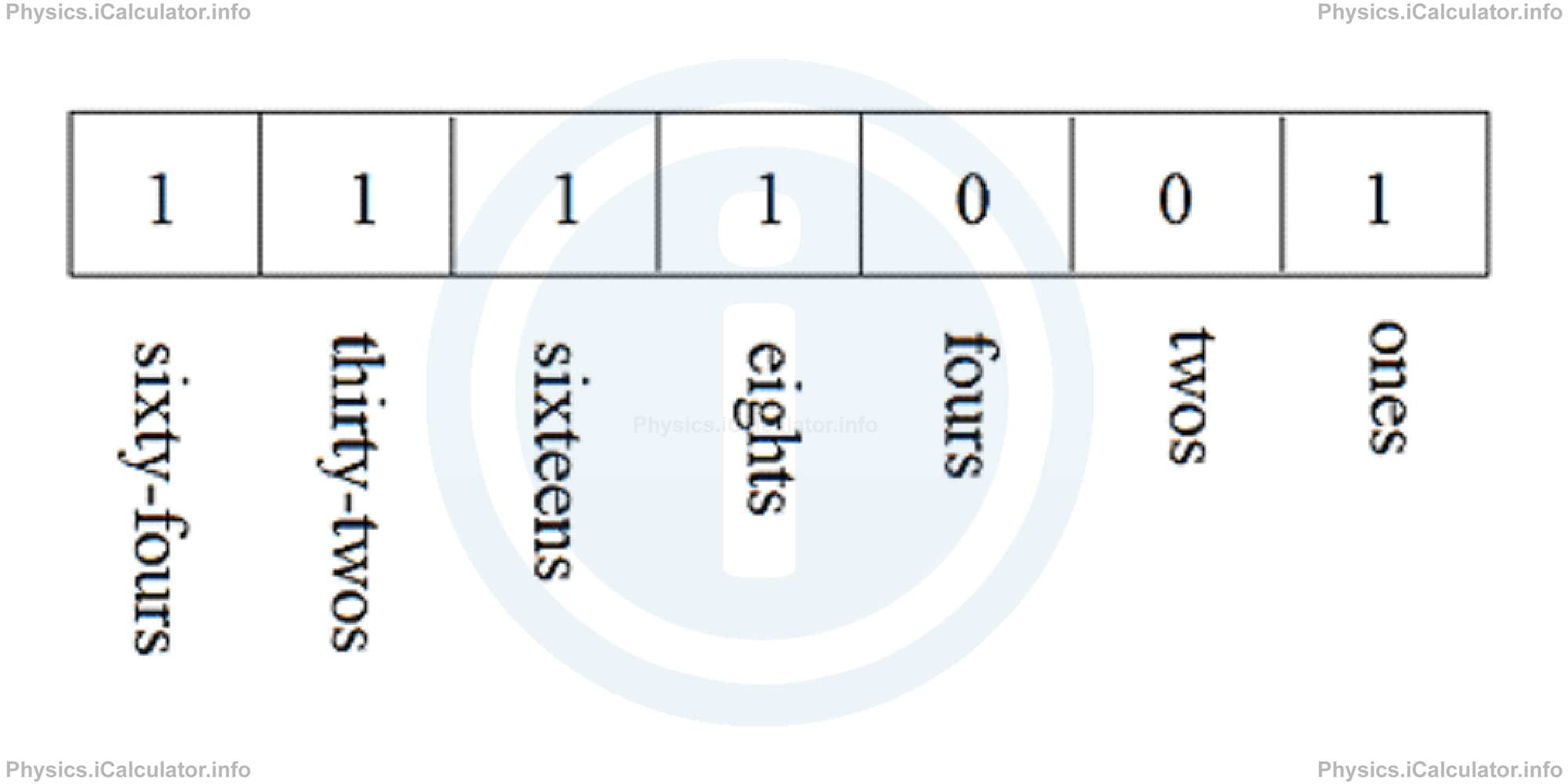Menu
Physics Lesson 17.1.3 - Number Systems. Binary System
Please provide a rating, it takes seconds and helps us to keep this resource free for all to use
Welcome to our Physics lesson on Number Systems. Binary System, this is the third lesson of our suite of physics lessons covering the topic of Electronic Essentials: Analogue and Digital Signals, Binary Operations and Logic Gates, you can find links to the other lessons within this tutorial and access additional physics learning resources below this lesson.
Number Systems. Binary System
In daily life, we use the decimal system to represent numbers. This is a base 10 number system, i.e. there are 10 digits used to represent the numbers. These digits are: 0, 1, 2, 3, 4, 5, 6, 7, 8 and 9. We can write every number by combining these 10 digits. In the decimal system, the value of a certain digit increases 10 times when moving from right to left.
The digits in the decimal system are placed in their place value. The smallest place value is that of units (ones); it is the rightmost digit of the number. Then, there are tens, then hundreds and so on. Look at the figure below.

The number 304197 can split as
304197 = 3 × 100000 + 0 × 10000 + 4 × 1000 + 1 × 100 + 9 × 10 + 7 × 1
This number can be expressed in terms of powers of tens as
304197 = 3 × 105 + 0×104 + 4 × 103 + 1 × 102 + 9×101 + 7× 100
(Recall that 100 = 1).
In digital electronics however, we use the binary system instead of decimal system. As stated earlier, the binary system includes only two digits: 0 and 1. This system is used for convenience, as it is much easier for computers to recognize and process only two types of signals instead of ten types of different signals contained in the decimal number system. In this regard, a decimal number written as a combination of only two digits: 0 and 1, represents a binary number, whose place values are powers of 2 instead of powers of 10.
The similarity between these two number system consists on the value of place values, which increase from right to left in both systems. However, in binary system a given digit has twice the value of the same digit on its left. In the decimal system, this factor of increase is 10 times.
For example, the value of binary number 10110010 when written using the decimal system is
(10110010)2 = 1 × 27 + 0 × 26 + 1 × 25 + 1 × 24 + 0 × 23 + 0 × 22 + 1 × 21 + 0 × 20
= 1 × 128 + 0 × 64 + 1 × 32 + 1 × 16 + 0 × 8 + 0 × 4 + 1 × 2 + 0 × 1
= 128 + 32 + 16 + 2
= 178
Thus, the binary number 10110010 corresponds to 178 in the decimal system.
We can convert a decimal number to a binary one as well. For this, we must consider the remainders of the division by two and write them from the last to the first. For example, if we want to express the number 89 as a binary number, we obtain
89 ÷ 2 = 44 (1)
44 ÷ 2 = 22 (0)
22 ÷ 2 = 11 (0)
11 ÷ 2 = 5 (1)
5 ÷ 2 = 2 (1)
2 ÷ 2 = 1 (1)
1 ÷ 2 = 0 (1)
(89)10 = (1111001)2
If we write the above number according the scheme used earlier, we have for the above number:

Another number system which is worth to discuss and which is widely used in digital electronics is the hexadecimal system. It is a number of system containing 16 digits, from 0 to 15. However, the numbers from 10 to 15 are expressed using the letters from A to F. For example, the decimal equivalent of the hexadecimal number A8B3 is
(A8D3)16 = 10 × 163 + 8 × 162 + 13 × 161 + 3 × 160= 10 × 4096 + 8 × 256 + 13 × 16 + 3 × 1= 40960 + 2048 + 208 + 3= (43219)10= 43 219
For decimal numbers it is not necessary to write the base as a subscript.
You have reached the end of Physics lesson 17.1.3 Number Systems. Binary System. There are 5 lessons in this physics tutorial covering Electronic Essentials: Analogue and Digital Signals, Binary Operations and Logic Gates, you can access all the lessons from this tutorial below.
More Electronic Essentials: Analogue and Digital Signals, Binary Operations and Logic Gates Lessons and Learning Resources
Whats next?
Enjoy the "Number Systems. Binary System" physics lesson? People who liked the "Electronic Essentials: Analogue and Digital Signals, Binary Operations and Logic Gates lesson found the following resources useful:
- Systems Feedback. Helps other - Leave a rating for this systems (see below)
- Electronics Physics tutorial: Electronic Essentials: Analogue and Digital Signals, Binary Operations and Logic Gates. Read the Electronic Essentials: Analogue and Digital Signals, Binary Operations and Logic Gates physics tutorial and build your physics knowledge of Electronics
- Electronics Revision Notes: Electronic Essentials: Analogue and Digital Signals, Binary Operations and Logic Gates. Print the notes so you can revise the key points covered in the physics tutorial for Electronic Essentials: Analogue and Digital Signals, Binary Operations and Logic Gates
- Electronics Practice Questions: Electronic Essentials: Analogue and Digital Signals, Binary Operations and Logic Gates. Test and improve your knowledge of Electronic Essentials: Analogue and Digital Signals, Binary Operations and Logic Gates with example questins and answers
- Check your calculations for Electronics questions with our excellent Electronics calculators which contain full equations and calculations clearly displayed line by line. See the Electronics Calculators by iCalculator™ below.
- Continuing learning electronics - read our next physics tutorial: Electronic Components and Switching
Help others Learning Physics just like you
Please provide a rating, it takes seconds and helps us to keep this resource free for all to use
We hope you found this Physics lesson "Electronic Essentials: Analogue and Digital Signals, Binary Operations and Logic Gates" useful. If you did it would be great if you could spare the time to rate this physics lesson (simply click on the number of stars that match your assessment of this physics learning aide) and/or share on social media, this helps us identify popular tutorials and calculators and expand our free learning resources to support our users around the world have free access to expand their knowledge of physics and other disciplines.